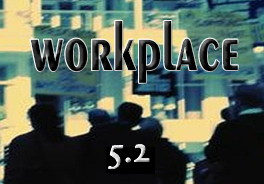"I Participate,
You Participate, We Participate…”
Notes
on Building a K-16 Movement for Democracy
and
Social Justice
Greg Queen, E. Wayne Ross, Rich Gibson,
& Kevin D. Vinson
What Is the Rouge Forum?
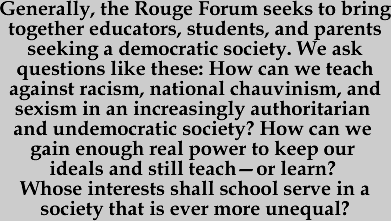 boundaries. The other two Detroit rivers were paved, early in the life
of the city, and now serve as enclosed running sewers. Of the three, the
Rouge is the survivor.
boundaries. The other two Detroit rivers were paved, early in the life
of the city, and now serve as enclosed running sewers. Of the three, the
Rouge is the survivor.
1.4 Henry Ford owned Dearborn and its politicians. Ford was and is an international carmaker and a long-time practitioner of globalism. And, Henry Ford was a fascist. He contributed intellectually and materially to fascism and his anti-Semitic works inspired Hitler. Ford accepted the German equivalent of the Medal of Honor from Hitler, and his factories continued to operate in Germany, untouched by allied bombs, throughout WWII.
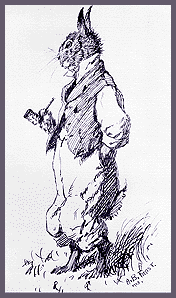 simultaneously
struggle to bring into practice our present understanding of what that
is. We seek to build a caring inclusive community that understands that
an injury to one is an injury to all. At the same time, it is recognized
that our caring community is going to need to deal decisively with an
opposition that is sometimes ruthless.
simultaneously
struggle to bring into practice our present understanding of what that
is. We seek to build a caring inclusive community that understands that
an injury to one is an injury to all. At the same time, it is recognized
that our caring community is going to need to deal decisively with an
opposition that is sometimes ruthless.
1.11
Although the first official meeting of the Rouge Forum was held at Wayne
State University in Detroit, June 1998, the impetus for this meeting stretches
back to 1994 and anti-racist and free speech activism within the National
Council for the Social Studies (NCSS).
Origins of the Rouge Forum : National Council for the Social Studies, Phoenix 1994
The Arrest and Trials of Sam Diener 1
3.3 As the one-sided version of the events was given, portraying Diener as disrupting the concert, members of the audience [primarily social studies teachers with leadership positions in state level social studies councils] ridiculed Deiner’s leafleting and many portrayed leafleting as a major crime. Some…suggested Diener should go to jail with “the key thrown away.” (p. 3)
3.4 Stephen C. Fleury, a member of the House of Delegates presented Diener’s version of events based on the free speech leaflet Diener and Wong had been distributing. Fleury described the scene this way:
As I began to read Diener’s story, I felt momentary relief when the delegates began to laugh at what I perceived to be the absurdity and irony of Diener’s arrest. Relief was quickly replaced with horror, however, when I realized the delegates’ were amused that Diener (and others advocating for him) might believe that social activism was reasonable behavior at a social studies education conference…When the final vote was taken, however, the appeal to exonerate Diener was soundly defeated. (Fleury, 1998, pp. 4-5)
CUFA, Proposition 187, and the Boycott of California
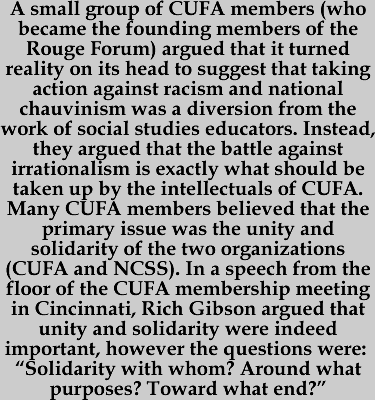 do the same. Over 500 press releases announcing CUFA's actions were sent
to media outlets, professional organizations, elected officials, and convention
and tourism bureaus in California. NCSS responded by attempting to suppress
the Emergency's Committee's work; while the elected leadership of CUFA
took no action to implement the resolution's provisions (Ross, 1997, 1998).
The debate within CUFA regarding action (or non-action) on the boycott
issue remained on low heat for several years despite a special symposium
on "The Role of Social Studies Educators as Scholars and Advocates" at
CUFA's 1995 meeting in Chicago.
do the same. Over 500 press releases announcing CUFA's actions were sent
to media outlets, professional organizations, elected officials, and convention
and tourism bureaus in California. NCSS responded by attempting to suppress
the Emergency's Committee's work; while the elected leadership of CUFA
took no action to implement the resolution's provisions (Ross, 1997, 1998).
The debate within CUFA regarding action (or non-action) on the boycott
issue remained on low heat for several years despite a special symposium
on "The Role of Social Studies Educators as Scholars and Advocates" at
CUFA's 1995 meeting in Chicago.
4.5 In November 1997, at annual meetings of NCSS and CUFA in Cincinnati, both groups retreated from previous decisions on the California boycott. The NCSS Board of Directors made a sudden about-face rescinding their spring decision, apparently under pressure from leaders of the California Council for the Social Studies.
4.10 Seven months later, the Rouge Forum was organized and held its first meeting in Detroit. Continued activism within CUFA and NCSS remained a major topic of discussion at this meeting—issues included: continuing the dialogue on overt political action by both CUFA and NCSS; the social and political responsibilities of educators; the role of researchers and research findings in ameliorating social ills; and the unique position of social studies curriculum and teaching as a force against racism and fascism. The ideas and actions of these social studies educators and their actions at the NCSS conferences during this period illustrate the activist roots of the Rouge Forum. The following section explains a key operative principle for the actions of the Rouge Forum—the idea that schools hold a centripetal position in North American society and educators play a critical role in the creation of a more democratic egalitarian society, or one that increases inequality and authoritarianism.
The Centripetal Position of Schools in North American Society 4
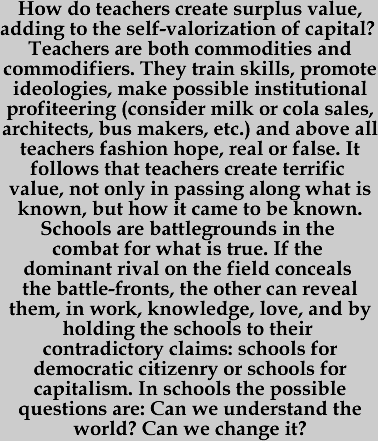 5.1
Schools hold a centripetal position in North American society. One in
four people in the US are directly connected to schools: school workers,
students, parents. Many others are linked in indirect ways. Schools
are the organizing point for most people's lives, in part, because of
the deindustrialized nature of North America and, in part, the absence
of serious struggle emanating from the industrial working class, despite
its historical civilizing influence. School is not merely school, but
the point of origin for health care, food, and daytime shelter for many
people. Schools are also huge markets (consider the bus purchases, architectural
and building costs, salaries, and potential for corruption), as well as
bases for technological instruction and skill training. Schools warehouse
children, serving as an important tax supported day care system for companies
whose increasingly poorly paid workers come from dual income family who
see their children an average of 20 hours less a week than they did in
1979. The beginning point in understanding the role teachers play as major
actors in a centripetally positioned organization is to understand the
value teachers create within capitalist societies. This is what Marx had
to say:
5.1
Schools hold a centripetal position in North American society. One in
four people in the US are directly connected to schools: school workers,
students, parents. Many others are linked in indirect ways. Schools
are the organizing point for most people's lives, in part, because of
the deindustrialized nature of North America and, in part, the absence
of serious struggle emanating from the industrial working class, despite
its historical civilizing influence. School is not merely school, but
the point of origin for health care, food, and daytime shelter for many
people. Schools are also huge markets (consider the bus purchases, architectural
and building costs, salaries, and potential for corruption), as well as
bases for technological instruction and skill training. Schools warehouse
children, serving as an important tax supported day care system for companies
whose increasingly poorly paid workers come from dual income family who
see their children an average of 20 hours less a week than they did in
1979. The beginning point in understanding the role teachers play as major
actors in a centripetally positioned organization is to understand the
value teachers create within capitalist societies. This is what Marx had
to say:
The only worker who is productive is one who produces surplus value for the capitalist, or in other words contributes to the self-valorization of capital. If we may take an example from outside the sphere of material production, a schoolmaster is a productive worker when, in addition to belaboring the heads of his pupils, he works himself into the ground to enrich the owner of the school. That the latter has laid out his capital in a teaching factory, instead of a sausage factory, makes no difference to the relation. The concept of a productive worker therefore implies, not merely a relation between the activity of work and its useful effect, between the worker and the product of the work, but also a specific social relation of production, a relation with a means of valorization. To be a productive worker is therefore not a piece of luck, but a misfortune. (Marx, 1977, p. 644)
5.2 A paradox of school is that the freedom to struggle for the methods to gain and test truth is often greatest in the richest and poorest schools—where youth have often learned that the construction of rational knowledge is a waste of time. But across the spectrum, school is most free for the working class. We believe teaching against the destruction of reason is possible in US public schools. Given that the crisis of the present age is not a crisis of material scarcity, but a crisis of consciousness—that is, the abundance that is necessary for a democratic and egalitarian society is at hand, what is missing is the decision to gain it—the role of educators in creating critical consciousness is even more vital. A base of solidarity, structured with an understanding of the collective value school workers of all kinds create, and the subsequent struggle to control value in the workplace and community makes defense possible.
Why Standards-Based Educational Reforms & High-Stakes Testing are Key Rouge Forum Issues 5
Regulating Education and the Economy 6
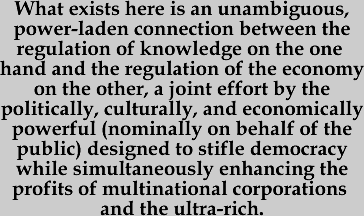 scores
and high drop out rates, even though both of these measures are less a
reflection of student ability or achievement than a measure of parental
income.
scores
and high drop out rates, even though both of these measures are less a
reflection of student ability or achievement than a measure of parental
income.
7.2 The research over the past two decades indicates test-based educational reforms do not lead to better educational policies and practices. Indeed, such testing often leads to educationally unjust consequences and unsound practices. These include increased drop-out rates, teacher and administrator de-professionalization, loss of curricular integrity, increased cultural insensitivity, and disproportionate allocation of educational resources into testing programs, and not into hiring qualified teachers and providing enriching sound educational programs (Amrein & Berliner, 2002; Haney, 2000).
7.4 Ensconced within this alliance is an insidious move on the part of elite stakeholders toward the corporate/state regulation and administration of knowledge, a move that enables what Noam Chomsky calls “systems of unaccountable power” to make self-interested decisions ostensibly on behalf of the public when, in fact, most members of the public have no meaningful say in what or how decisions are made or in what can count as legitimate knowledge. This, of course, is purposeful and involves the coordinated control of such pedagogical processes as goal-setting, curriculum development, testing, and teacher education/ evaluation, the management of which works to restrict not only what and who can claim the status of “real” knowledge, but also who ultimately has access to it (see Mathison & Ross, 2002).
Reaching Out: Building Connections and Grassroots Organizing 7
8.2 In recent years, the impact of being a common target has caused several members of distinct educational movements to come together for joint projects. Many groups are more seriously considering the power of interdependence in seeking reason and social justice. As a result, advocates of the whole language approach to literacy education, inclusion, and critical pedagogy are engaging in more dialogue and have began to work together, to re-discover their natural unity–-and seeing serious differences at the same time. The crux of those differences seems to revolve around the question: Can capitalism be reformed, tamed, made gentler, or not and, if not, then what?
A Natural Unity: Whole Language, Inclusion and Critical Pedagogy
9.1
For a time, many people within the whole language movement saw their outlook
as simply a teaching philosophy, one that stood outside politics. The
inclusive education movement likewise was viewed less politically. The
idea of special education inclusion, however, has challenged ideologies
and career paths at all levels. At the same time, the critical pedagogy
movement became so divorced from daily life in the socio-political world
that it lost sight of ways in which social change can be activated. Perhaps
born in the same well-springs, the three movements diverged so completely
that they lost sight of one another. A few well-known individuals from
each camp 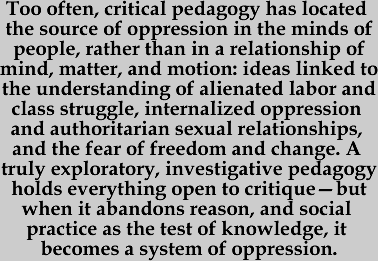 stay
in touch and reach out to school-workers, parents, and students to demonstrate
the inseparability of political work, whole language, and critical teaching.
Among this group, Ken and Yetta Goodman, Gerald Coles, Patrick Shannon,
Susan Ohanian, Carol Edelsky, Gerry Oglan, Michael Peterson, and Valerie
Ooka Pang stand out. (Appendix D describes some tenets of whole language,
critical pedagogy, and inclusive education that provide a springboard
for speculating about their intersections and illustrates their inter-relationships.)
stay
in touch and reach out to school-workers, parents, and students to demonstrate
the inseparability of political work, whole language, and critical teaching.
Among this group, Ken and Yetta Goodman, Gerald Coles, Patrick Shannon,
Susan Ohanian, Carol Edelsky, Gerry Oglan, Michael Peterson, and Valerie
Ooka Pang stand out. (Appendix D describes some tenets of whole language,
critical pedagogy, and inclusive education that provide a springboard
for speculating about their intersections and illustrates their inter-relationships.)
9.3 Critical pedagogy advocates have sometimes failed to acknowledge the elitist roots of their theory. In some instances, critical pedagogy has served the interests of new elites rather than the interests of social democracy and economic equality. In this sense, critical pedagogy has failed the test of material equality. Too often, critical pedagogy has located the source of oppression in the minds of people, rather than in a relationship of mind, matter, and motion: ideas linked to the understanding of alienated labor and class struggle, internalized oppression and authoritarian sexual relationships, and the fear of freedom and change (see Hill, McLaren, Cole & Ritkowski, 2002; McLaren, 2000). A truly exploratory, investigative pedagogy holds everything open to critique—but when it abandons reason, and social practice as the test of knowledge, it becomes a system of oppression.
9.4 The message of Whole Language is centered on the totality, the wholeness, inter-relatedness of knowledge. The focus of the inclusion movement has been the unity of people, all people. The heart of critical pedagogy is that we can understand and transform the world—in the interest of masses of people.
Whole Schooling
10.1 In 1997, colleagues from Michigan and Wisconsin collaboratively developed a framework for improving schools that draws from and builds on the experiences of progressive school reform organizations nationally, particularly Accelerated Schools, Comer's School Development Program, Howard Gardner's Project Zero, and Sizer's Coalition for Essential Schools. Like the developers of these programs we are concerned with several continuing facts of schooling: (1) Lack of connections among schools, families, and communities; (2) Dominant instructional strategies that are disjointed, purposeless, boring and disconnected from the real lives as well as family and community experience of students; and (3) The need for democratic processes of decision-making in schools that empower students, families, teachers, and other school staff. Moreover, we have also been concerned about the lack of explicit attention to two major additional dimensions of schooling: (4) The ongoing segregation of students with different learning styles and abilities into special programs for students with disabilities, at risk, gifted, limited English proficiency; and (5) The lack of attention to the social and political context of schooling—the increasing inequality in schools and communities, pressures for standardized testing that separate students, families, and whole communities and educational workers—by race, socio-economic status, and ability. (See http://golem.coe.wayne.edu/CommunityBuilding/WSC.html)
10.2 On the whole, we agree that the following factors comprise what we called an honest education:
A teacher/student/community search for what is true, gaining and testing ideas in a reasonably free atmosphere where passion and joy are privileged;
Exploratory curricula linked to the world and a specific community (e.g., let's map a Detroit playground, now let's map a playground in Grosse Pointe—and then a playground in Grenada);
Critical and anti-racist curricula—as in analyzing the history and practice of racism;
Pedagogy and content rooted in democracy (e.g., how come Detroiters’ votes count so little when it comes to casinos or their school board-or at work or school?);
Meaningful and creative pedagogy fashions a meeting of the teachers and the students where they are at (e.g., let's design our plan for the year together; understanding that we all start at different places, but that we want to head in the same direction),
Inclusive and hence rational schools (e.g., crossing boundaries of race, sex, and ability not only in the studies but in who is present in the classroom).
By 1997 our discussions had produced what came to be called the Whole Schooling model for school reform, which is based on five principles. These are summarized below. Empower citizens in a democracy: The goal of education is to help students learn to function as effective citizens in a democracy.
Include all: All children learn together across culture, ethnicity, language, ability, gender and age.
Authentic teaching and adapting for diverse learners: Teachers design instruction for diverse learners that engages them in active learning in meaningful, real-world activities; develop accommodations and adaptations for learners with diverse needs, interests, and abilities.
Build community and support learning: The school uses specialized school and community resources (special education, Title I, gifted education) to build support for students, parents, and teachers. All work together to build community and mutual support within the classroom and school; provide proactive supports for students with behavioral challenges.
Partner with families and the community: Educators build genuine collaboration within the school and with families and the community; engage the school in strengthening the community; and provide guidance to engage students, parents, teachers, and others in decision-making and direction of learning and school activities.
Expanding the Rouge Forum Issues
Grassroots Organizing
12.2 Meetings, interactive conferences and teach-ins—The Rouge Forum along with members of Whole Schooling have made presentations at a variety of professional organizations including the American Educational Research Association, National Council for the Social Studies, The Association for Persons with Severe Handicaps (TASH), the International Social Studies Conference, Michigan Council for the Social Studies, and the Socialist Scholars Conference and have held a number of meetings and interactive conferences in Detroit, Albany, Binghamton, Rochester, Orlando, Calgary and this summer in Louisville, Kentucky. The united groups have also sponsored exhibitor booths at many of these conferences. Articles about the Whole Schooling Consortium and Rouge Forum have appeared in Theory and Research in Social Education, Wisconsin School Board Journal, Substance, and Z Magazine.
12.3 In cooperation with the Whole Schooling Consortium and the Whole Language Umbrella, we co-sponsored the 2000 International Education Summit for a Democratic Society. It convened progressive educators, teachers, parents, and community members locally and throughout the country. The Summit was an event designed to promote learning and skill development, dialogue, connecting urban, rural, and suburban schools, and organizing to strengthen progressive education for an inclusive and democratic society. It linked art, music, drama, celebrations with ideas, organizing, relationship building. It was an interactive, action-oriented conference propelled by the belief that learning is both personal and social and that classrooms and other educational settings must be learning communities.
12.4 At times our sessions in professional conferences are disrupted by standardistos (e.g., test-pushers and advocates of the standardization and state regulation of knowledge). For example, at the 2000 NCSS convention in San Antonio, the audience shouted down a state education bureaucrat who repeatedly disrupted a workshop on resisting high-stakes tests. On the other hand…We identify education bureaucrats as fair targets and distributed “MEAP SCHMEAP BINGO” to incoming participants at Michigan Council for the Social Studies convention, sessions led by bureaucrats of the Education or Treasury Department—Michigan Education Assessment Program (MEAP) is Michigan’s high-stakes test, which is administered by the state Treasury Department.
12.5 Media—We use the complete range of media opportunities, from traditional, “low-tech/high-touch” approaches such as leafleting to use of cyberspace. Many opportunities are available to distribute leaflets and broadsides. (Past broadsides and other flyers are available on the Rouge Forum web site.) At conferences, we place flyers throughout the conference center, and we distribute flyers at social justice events, grocery stores, universities and schools. Flyers used to develop connections with potential allies and provide an entrée for face-to-face discussion. In the planning of the many public activities like the demonstrations and teach-ins, we make contacts to local media and subsequently see our events reported through them, usually with a positive write-up. Many members also write op-ed articles or letters to the editor in local papers. We participate in radio and television interviews, usually focusing on the social context of educational reform, standards-based education and high-stakes testing, which often result from press coverage of our meetings or opinion pieces in newspapers and magazines.
12.6 We have a website—http://www.RougeForum.org—that not only informs folks of future Rouge Forum events but provides thousands of connections to information that facilitates a theoretical and practical understanding to achieve a more equal and democratic world. Beyond the baseline subscribers, nearly 200,000 people visited the Rouge Forum web page in 2002, and, in early 2003, 4,000 people visited the web page each week.
12.7 In 1999, the Rouge Forum News was launched. Its goal is to include voices from educators, students and parents. We produce at least three forty-page issues annually, each issue is archived on the Rouge Forum web site.
12.8 Demonstrations and other “events”—The Rouge Forum has sponsored or co-sponsored numerous demonstrations in New York, Michigan, and California. With the Whole Schooling Consortium in Michigan, we sponsored a rally to “SUPPORT GOOD TEACHING, GET RID OF THE MEAP.” Our goals were to provide a place where people could comfortably take a public stand and to gain additional people with whom we could work. We sent press releases and three major TV stations covered the demonstration and aired footage of interviews of participants. We had an "open mike" session and more than a dozen people spoke for 2 to 3 minutes each about their reasons for opposing high stakes testing, specifically the MEAP. We marched with signs and chants about their opposition to high stakes tests; most were wearing buttons protesting the MEAP and high stakes tests. During the march many onlookers honked and cheered their support. Following the march we met for refreshments and talk and made plans for continuing our work to educate others about high-stakes testing and what they can do about it.
12.9 In a collaborative effort, the Rouge Forum and Whole Schooling participate in community debates. In one such debate, the leader of the Michigan Chamber of Commerce and the executive director of merit awards (the department responsible for distributing the bribes that the State of Michigan pays out to primarily suburbanites for “passing” the state tests) presented opposing viewpoints, supporting standards-based education and high-stakes testing.
12.10 We work collaboratively with some state legislators to challenge other policy makers to take the tests that they expect students to take. While most of the legislators were no-shows and we encouraged parents, teachers and students to follow the example set by policy makers by boycotting the tests. Some Rouge Forum members feared that by bringing attention to the tests, it would legitimize them. However, we found two solutions to the problem. First, a participant was immediately handed a form to sign that would opt him/herself out of the tests. Secondly, when policy-makers were finished taking the tests, their scores were determined by the average income level of the district they represent. The best predictor of a school district's test scores is the average income of the parents.
12.11 Working inside other organizations—During professional conferences in organizations such as the National Council for the Social Studies and their state affiliates, the Rouge Forum has sponsored booths that provide literature and space for conversation around important education and social justice issues. These spaces are useful places to meet people and have lengthy one-to-one chats with rank-and-file teachers as well as students. Our coffee maker lends a living room atmosphere to the conversations. In the evenings, we frequently dine with new friends and Rouge Forum members.
12.12 Members of the Rouge Forum brought two key resolutions to the National Council for the Social Studies conference in San Antonio on November 18, 2000. The two resolutions, reproduced in the Appendices E and F, address open access and free tuition to universities, and opposition to high-stakes tests. The motions were first presented to the members of the College and University Faculty Association (CUFA), composed of professors, the evening before the House of Delegates meeting of NCSS.
12.13 The motion on Open Access was defeated, about two-to-one, due at least in part to the opposition of multi-culturalists like James Banks, who spoke fervently, worrying that free tuition might cut professors’ salaries. The resolution opposing High-Stakes Tests, however, passed unanimously, a surprise for even the most optimistic of Rouge Forum members. The language of the CUFA resolution in opposition to high-stakes exams is the sharpest to come out of any of the professional organizations or the two education-worker unions. The NCSS House of Delegates voted down CUFA’s high-Stakes resolution, after very brief debate during which the members were warned that if the high-stakes were abolished, social studies teachers might lose their jobs. Meanwhile, related groups that oppose high-stakes exams began to circulate the resolution around the US on email listservs, urging contact people to bring the proposal to union locals, PTA groups, and administrator organizations. The resolutions influenced other professional groups that have developed statements on the deleterious effects of high-stakes testing (e.g., American Evaluation Association).
Summary
References
Amrein, A. L. & Berliner, D.C. (2002, March 28). High-stakes testing, uncertainty, and student learning. Education Policy Analysis Archives, 10(18). Retrieved April 29, 2003 from http://epaa.asu.edu/epaa/v10n18/.
Berliner, D., & Biddle, B. (1996). The manufactured crisis. Reading, MA: Addison Wesley.
Dewey, J. (1966) Democracy and education. New York: Macmillan.
Fleury, S. C. (1998, November). A Sunday afternoon in the House of Delegates. Paper presented at the annual meeting of College and University Faculty Assembly of National Council for the Social Studies as part of the symposium, Anaheim.
Freire, P. (2000) . Pedagogy of the oppressed. New York: Continuum.
Haney, W. (2000). Myth of the Texas miracle. Education Policy Analysis Archives, 8(41). Retrieved April 29, 2003 from http://epaa.asu.edu/epaa/v8n41/.
Hursh, D. W. (1998, November). The First Amendment and free speech at the National Council for the Social Studies: The arrest and trials of leafleteer Sam Diener. Paper presented at the annual meeting of the College and University Faculty Assembly of National Council for the Social Studies, Anaheim.
Hill, D., McLaren, P., Cole, M., & Rikowski, G. (Eds.). (2002). Marxism against postmodernism in educational theory. Lanham, MD: Lexington Books.
Ladson-Billings, G. (1998). Letters. Theory and Research in Social Education, 26 (1), 6-8
Marciano, J. (1997). Civic illiteracy and education: The battle for the hearts and minds of American youth. New York: Peter Lang.
Marx, K. (1985). Capital, Volume I. New York. International.
Mathison, S., & Ross, E. W. (2002). Hegemony of accountability in schools and universities. Workplace: A Journal for Academic Labor, 5(1). Available online: http://www.louisville.edu/journal/workplace/issue5p1/5p1.html
McLaren, P. (2000). Che Guevara, Paulo Freire, and the pedagogy of revolution. Lanham, MD: Rowman and Littlefield.
More on CUFA's resolution to boycott the NCSS California meeting. (1997, Spring). CUFA News, p. 4-5.
Ross, E. W. (1997). A lesson in democracy? CUFA, Proposition 187, and the Boycott of California. Theory and Research in Social Education, 25(3), 256-258, 390-393.
Ross, E. W. (1998). Democracy and disagreements: Some things to do on our way to Anaheim. Theory and Research in Social Education, 26 (1), 9-11.
Vinson, K. E., & Ross, E. W. (In press). Image and education: Teaching in the face of the new disciplinarity. New York: Peter Lang.
Vinson, K. D., & Ross, E. W. (2001, March). What can we know and when can we know it? Z Magazine, 14(3), 34-38.
Young, I. M. (1992). Five faces of oppression,
In T. E. Wartenburg (Ed.), Rethinking power (pp. 174-195). Albany:
State University of New York Press.
1 The basis of this section is David Hursh’s detailed account of Sam Diener’s arrest in “The First Amendment and free speech at the National Council for the Social Studies: The arrest and trials of leafleteer Sam Diener,” and Stephen C. Fleury’s “A Sunday Afternoon in the House of Delegates.” Both papers were presented to the College and University Faculty Assembly of the National Council for the Social Studies as part of the symposium “The journey from Phoenix to Anaheim: Institutional identities and political engagements of CUFA and NCSS, 1994-1998,” Anaheim, California, November 19, 1998.
2 The College and University Faculty Assembly (CUFA) is an "associated group" of National Council for the Social Studies and operates as an autonomous organization within the larger structure of NCSS.
3 The CUFA Resolution on Proposition 187 was written and sponsored by Perry Marker, Stephen C. Fleury, and E. Wayne Ross. The text of the resolution can be found in Ross (1997).
4 This section draws on Rich Gibson’s “Outfoxing the Destruction of Reason and the Introduction,” which appeared in Theory and Research in Social Education, Spring 2001 from a special issue of Cultural Logic, 4(1), http://www.eserver.org/clogic
5 This section draws from Rich Gibson’s “Outfoxing the Destruction of Reason.”
6 This section is draws from E. Wayne Ross and Kevin Vinson’s What We Can Know and When We Can Know It: Education Reform, Testing and the Standardization Craze, Z Magazine, March 2001.
7 This section is
draws on “Whole Schooling: Implementing progressive school reform” in
The Social Studies Curriculum, E. W. Ross (Ed.), Albany:
NY: State University of New York Press, 2001.
Author Notes:
Greg Queen teaches social studies to high school
students in Warren, Michigan. He is an active member in the production
of the Rouge Forum newspaper. He has made presentations at local, state
and national conferences on high-stakes testing and the role of schools
in a capitalist society.
E. Wayne Ross is Distinguished University Scholar
and Chair of the Department of Teaching and Learning at the University
of Louisville. He is a co-founder of the Rouge Forum and a general editor
of Workplace and Cultural Logic.
Rich Gibson is Associate Professor in the College
of Education at San Diego State University and a co-founder of the Rouge
Forum.
Kevin D. Vinson is Assistant Professor in the College of Education at the University of Arizona and co-author, with E. Wayne Ross, of Image and Education: Teaching in the Face of the New Disciplinarity, forthcoming from Peter Lang.
